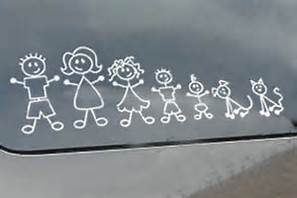
Perhaps you have heard the age-old adage, “a picture says a thousand words.” If you could invert the family in the picture above by placing the individuals in opposite order (shortest to tallest), and then draw a lined arrow which continues through the last family member, you would be looking at a picture of Next Generation Ministry.
We have become all too familiar with this picture of family members in the form of stick figures placed on the back window of vehicles. We like to count the number of figures and then also notice how many pets the family owns. Pets aside, a family is a unit that grows together. Through thick and then, a family hangs tight. I am sure you have heard of the expression, “a family that prays together stays together.” Most have rephrased this phrase today to say, “a family that plays together stays together.” That mantra has some credence but Scripture is clear that godliness holds value for “all things” while physical training is only of “some” value (I Tim 4:8).
A family left to themselves is never enough. The Bible has mandated in the Old Testament and the New Testament that the family partner with the church in the all-important task of raising children up in the way of the Lord. It truly does take a village to raise a child. Though parents will always be the primary disciple-makers of their children, parents should use the assistance of the local church in order to become a Great Commission family.
In NGM, family ministry is important, but there is more to the picture. Families look different today and churches must remember the spiritual orphan while planning. In NGM, church members can become the adopted spiritual parents for the spiritual orphans in the church. Michael and Michelle Anthony note in A Theology for Family Ministry, “what was once simply referred to as a Nuclear Family in North America has morphed into labels such as Non-Traditional Families, Fragmented Families, Single-Parent Families, Gay-Partner Families, Blended Families, and beyond.” Each church must wrestle with how they will minister to the different types of families found in their community.
The arrow that runs through the ages is the biblical strategy that NGM employs across its age-graded ministries (preschool, children, youth, college). In reality, multiple arrows could run through the age-graded ministry stick figures, representing multiple strategies such as the NGM’s mission strategy, education strategy, evangelism strategy, worship strategy, and so on.
The goal is neither Christian education nor spiritual formation in and of itself, but rather Christian formation. Holly Allen and Christine Ross define “Christian formation” as the process of Christians being formed, transformed, and conformed to the image of Christ by the Holy Spirit. Christians are actively involved in this process both personally and communally.[1] Christian formation is the exact point and place where Christian education and spiritual formation meet. Michelle Anthony and Megan Marshman state, “It’s in the marriage of information and formation that we have transformation.”[2]
Transforming students (birth-college) into disciples of Christ is the goal and NGM is the discipleship strategy of choice for many churches!
[1] Holly C. Allen and Christine L. Ross, Intergenerational Christian Formation: Bringing the Whole Church Together in Ministry, Community, and Worship (Downers Grove, IL: IVP Academic, 2012), 21.
[2] Anthony and Marshman, 7 Family Ministry Essentials, 81.
 The 2016 Rio de Janeiro Olympics hosted by Brazil finished up ten days ago. Perhaps no other Olympic sport competition captures the essence of Next Generation Ministry (NGM) better than the 4×100-meter relay race.
The 2016 Rio de Janeiro Olympics hosted by Brazil finished up ten days ago. Perhaps no other Olympic sport competition captures the essence of Next Generation Ministry (NGM) better than the 4×100-meter relay race.






 …that the next generation might know them, the children yet unborn, and arise and tell them to their children, Psalms 78:6 (ESV)
…that the next generation might know them, the children yet unborn, and arise and tell them to their children, Psalms 78:6 (ESV)